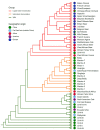The Ecology and Evolution of the Baker's Yeast Saccharomyces cerevisiae
- PMID: 35205274
- PMCID: PMC8871604
- DOI: 10.3390/genes13020230
The Ecology and Evolution of the Baker's Yeast Saccharomyces cerevisiae
Abstract
The baker's yeast Saccharomyces cerevisiae has become a powerful model in ecology and evolutionary biology. A global effort on field survey and population genetics and genomics of S. cerevisiae in past decades has shown that the yeast distributes ubiquitously in nature with clearly structured populations. The global genetic diversity of S. cerevisiae is mainly contributed by strains from Far East Asia, and the ancient basal lineages of the species have been found only in China, supporting an 'out-of-China' origin hypothesis. The wild and domesticated populations are clearly separated in phylogeny and exhibit hallmark differences in sexuality, heterozygosity, gene copy number variation (CNV), horizontal gene transfer (HGT) and introgression events, and maltose utilization ability. The domesticated strains from different niches generally form distinct lineages and harbor lineage-specific CNVs, HGTs and introgressions, which contribute to their adaptations to specific fermentation environments. However, whether the domesticated lineages originated from a single, or multiple domestication events is still hotly debated and the mechanism causing the diversification of the wild lineages remains to be illuminated. Further worldwide investigations on both wild and domesticated S. cerevisiae, especially in Africa and West Asia, will be helpful for a better understanding of the natural and domestication histories and evolution of S. cerevisiae.
Keywords: Saccharomyces cerevisiae; ecology; evolution; phylogeography; population genomics; yeast domestication.
Conflict of interest statement
The authors declare no conflict of interest.
Figures






References
-
- Liu L., Wang J.J., Levin M.J., Sinnott-Armstrong N., Zhao H., Zhao Y.A., Shao J., Di N., Zhang T.E. The origins of specialized pottery and diverse alcohol fermentation techniques in Early Neolithic China. Proc. Natl. Acad. Sci. USA. 2019;116:12767–12774. doi: 10.1073/pnas.1902668116. - DOI - PMC - PubMed
-
- Fatahi R., Ebadi A., Bassil N., Mehlenbacher S.A., Zamani Z. Characterization of Iranian grapevine cultivars using microsatellite markers. Vitis. 2003;42:185–192.
Publication types
MeSH terms
LinkOut - more resources
Full Text Sources
Molecular Biology Databases
Miscellaneous

